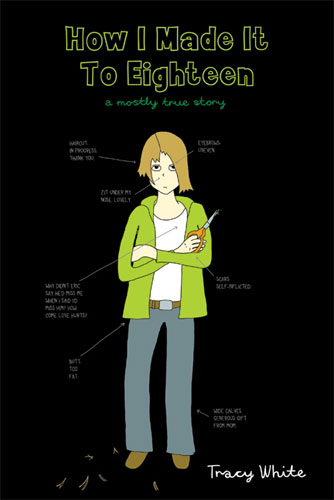
Review: How I Made It to Eighteen
Billed as a “mostly true story,” How I Made It to Eighteen is a memoir about mental illness, drug addiction, and recovery. Author Tracy White depicts herself at seventeen, as a recent high-school graduate working a dead-end job, dating a self-involved hipster, fighting with her mother, and feeling hopeless. (“I cried all the time. Even when I ate,” White reports.) After a half-hearted suicide attempt, White decided to check herself into a psychiatric hospital, a healing process which she documents in painfully honest detail in How I Made It to Eighteen.
How I Made It to Eighteen: A Mostly True Story
By Tracy White
Ages: 14 and up
June 2010, Roaring Brook Press, ISBN: 978-1596434547
160 pp., $16.99
 White’s narrative is refreshingly uneventful; she wisely avoids the trap of similar teens-in-distress stories by allowing her journey to self-awareness to unfold in a realistic fashion without the kind of false triumphs and setbacks that are characteristic of the genre. Instead, we watch her alter ego “Stacy Black” stumble through several stages of denial, clash with hospital staff, and talk a good game in a group session with other bulimics, only to purge a few hours later. Her progress is subtle — Stacy makes a small circle of friends within the teen ward, she accepts criticism from her peers — and sporadic; there are no “aha!” moments, no tearful confessions in the therapist’s office, and no happy reunion for Stacy and her mother at the end of the story.
White’s narrative is refreshingly uneventful; she wisely avoids the trap of similar teens-in-distress stories by allowing her journey to self-awareness to unfold in a realistic fashion without the kind of false triumphs and setbacks that are characteristic of the genre. Instead, we watch her alter ego “Stacy Black” stumble through several stages of denial, clash with hospital staff, and talk a good game in a group session with other bulimics, only to purge a few hours later. Her progress is subtle — Stacy makes a small circle of friends within the teen ward, she accepts criticism from her peers — and sporadic; there are no “aha!” moments, no tearful confessions in the therapist’s office, and no happy reunion for Stacy and her mother at the end of the story.
ADVERTISEMENT
ADVERTISEMENT
The book is divided into eight chapters, each of which is framed by an excerpt from Stacy’s patient file and interviews with four girls who knew Stacy at various stages in her life. I’m torn about this approach. On the one hand, Maria, Violet, Lola, and Ashely function as a kind of Greek chorus, revealing information about Stacy’s past that provides crucial insight into her behavior. On the other hand, White does a more persuasive job of recreating her seventeen-year-old voice than she does the other four girls’; though Stacy is believably prickly, sardonic, and self-absorbed, her friends sound too adult, teenage verbal mannerisms notwithstanding.
The artwork is stark and simple, as befits a hospital environment. The backgrounds are spare, with only a prop (e.g. a mirror, a couch) to establish the scene. These blank spaces make Stacy’s loneliness palpable to the reader; as we look at these empty, sterile settings, we feel Stacy’s estrangement from her mother and her high school friends. White’s figures, like her backgrounds, are more outlines than fully realized character designs, an aesthetic choice that nicely underscores the fact that Stacy and her friends aren’t yet adults; like the sparse interiors, they feel incomplete.
Though the artwork certainly plays an important role in telling Stacy’s story, it’s the script that really stays with the reader after finishing How I Made It to Eighteen, as White does an excellent job of explaining Stacy’s reasons for abusing drugs and food in an authentically adolescent voice. More importantly, White shows how Stacy learns to cope with her feelings, rather than succumb to them — an important example for teenagers who feel overwhelmed by the intensity of their own emotions. Even teens who aren’t grappling with such serious issues can identify with Stacy’s struggle to figure out who she is and how she fits in with her peers, making How I Made It to Eighteen an indispensable addition to any teen collection.
Review copy provided by the publisher.
Filed under: Graphic Novels, Reviews, Uncategorized
About Katherine Dacey
Katherine Dacey has been reviewing comics since 2006. From 2007 to 2008, she was the Senior Manga Editor at PopCultureShock, a site covering all aspects of the entertainment industry from comics to video games. In 2009, she launched The Manga Critic, where she focuses primarily on Japanese comics and novels in translation. Katherine lives and works in the Greater Boston area, and is a musicologist by training.
ADVERTISEMENT
ADVERTISEMENT
SLJ Blog Network
2024 Books from Pura Belpré Winners
In Memorium: The Great Étienne Delessert Passes Away
Parsing Religion in Public Schools
Finding My Own Team Canteen, a cover reveal and guest post by Amalie Jahn
ADVERTISEMENT








This is a really good book. Thumbs up! 😀